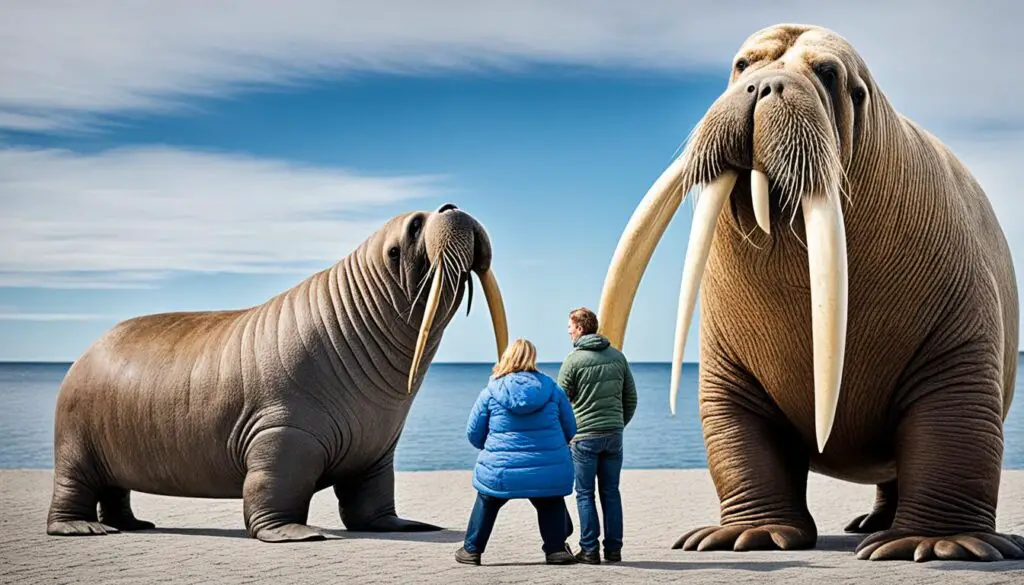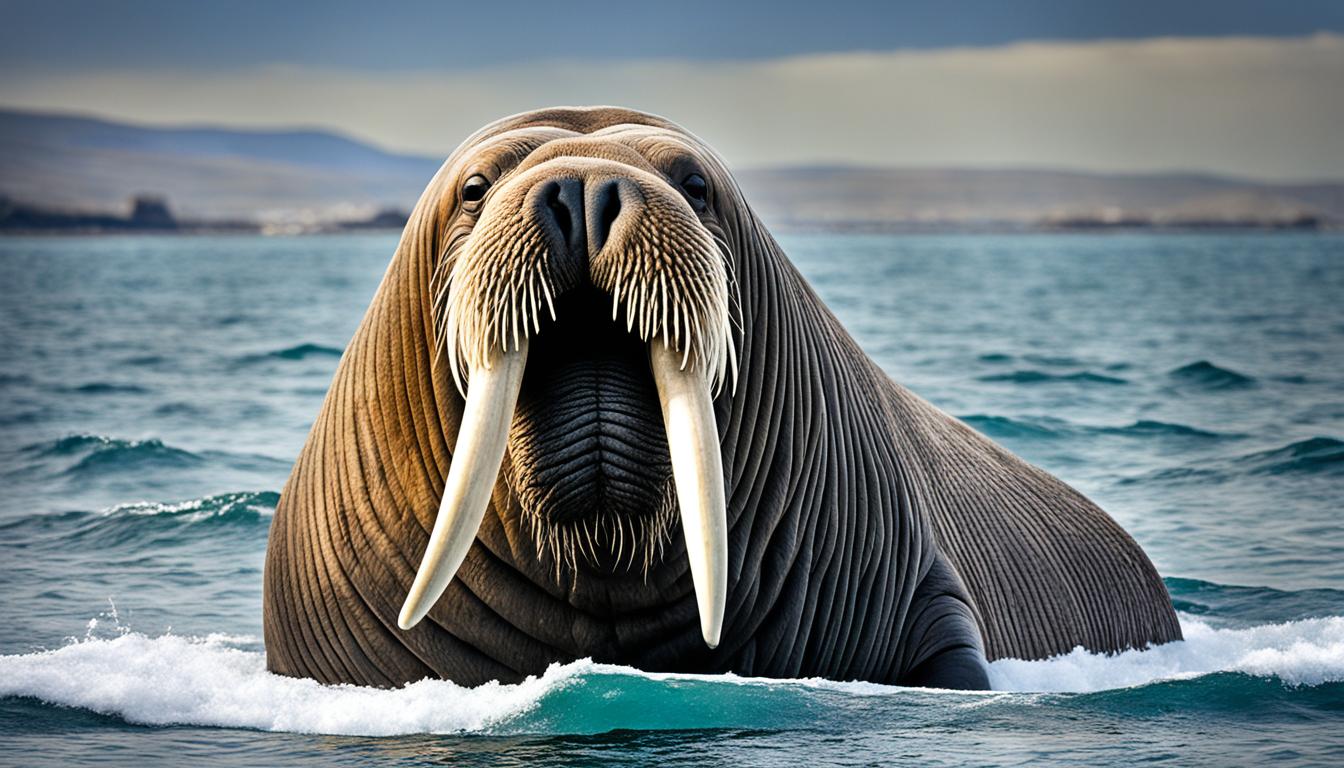Many people wonder: How big do walruses get? It’s important to know about walrus size to truly appreciate these amazing creatures. They live in icy waters and are quite large. This section will cover their size, including weight and length. By the end, you’ll know how big walruses are and why they’re unique.
Understanding Walrus Size
Walruses are big pinnipeds known for their size and impressive looks. They play a big role in the Arctic ecosystem. Males can weigh between 800 to 1,700 kg (1,764 to 3,748 lbs) and be 2.7 to 3.6 m (9 to 12 ft) long. Females are smaller, weighing about 400 to 1,250 kg (882 to 2,756 lbs) and measuring 2.3 to 3.1 m (7.5 to 10 ft) long.
There is a big difference in size between males and females. This difference is important for understanding their behavior and how they live. It shows how each gender has adapted to its role in the Arctic.
Walrus Dimensions and Measurements
Walruses come in different sizes, with the Atlantic walrus being smaller than the Pacific. Males can weigh about 908 kg (2,000 lb) and be around 2.4 m (8 ft) long. Pacific walruses are even bigger, making them stand out in size.
Here’s a table that shows how walruses compare to other marine mammals:
| Species | Average Weight (kg) | Average Length (m) |
|---|---|---|
| Atlantic Walrus | 908 kg | 2.4 m |
| Pacific Walrus | 1,200 kg | 3.6 m |
| Elephant Seal | 1,700 kg | 4.5 m |
Looking at these sizes, you see walruses are unique among large marine mammals. This info helps us appreciate their size and the variety among marine animals.
How big do walruses get?
Walruses are big marine mammals with unique sizes. Males and females differ in size, showing their roles in the ocean. This section will explore the size of male and female walruses and how they compare to other marine mammals.
Male Walrus Size
Male walruses are huge, weighing over 2,000 kg (4,400 lb) and reaching up to 4.9 m (16 ft) in length. Their size makes them powerful in their Arctic home. They use their size to compete for mates and lead their social groups.
Female Walrus Size
Female walruses are smaller than males, weighing about 1,000 kg (2,200 lb) on average. They are up to 3.0 m (10 ft) long. This size difference affects their role in raising young and meeting their energy needs.
Comparison to Other Pinnipeds
Walruses are among the biggest marine mammals, but not the biggest. Only elephant seals are larger. This shows how walruses are important in their ocean world.
| Species | Average Weight (kg) | Average Length (m) |
|---|---|---|
| Male Walrus | 2000+ | 4.9+ |
| Female Walrus | 1000 | 3.0 |
| Elephant Seal | 3000+ | 6.0+ |
| Harbor Seal | 100-200 | 1.5-2.0 |
Walrus Weight Range
Exploring the weight of walruses shows us the Pacific and Atlantic species have different weight ranges. These ranges help us see how males and females differ. They also show how the environment affects their weight.
Male Pacific Walrus Weight
The male Pacific walrus can weigh between 800 and 1,700 kg (1,764-3,748 lb.). Some males even reach over 2,000 kg (4,400 lb.). Their large size makes them stand out in the ocean.
Female Pacific Walrus Weight
Female Pacific walruses are much lighter, weighing from 400 to 1,250 kg (882-2,756 lb.). This shows how males are bigger than females.
Atlantic Walrus Weight Information
The Atlantic walrus also has interesting weights. Males weigh about 900 kg (2,000 lb.), and females around 560 kg (1,230 lb.). This info helps us understand the weight differences in walrus species.
| Type | Weight Range (kg) | Weight Range (lb) |
|---|---|---|
| Male Pacific Walrus | 800 – 1,700 | 1,764 – 3,748 |
| Female Pacific Walrus | 400 – 1,250 | 882 – 2,756 |
| Male Atlantic Walrus | 900 | 2,000 |
| Female Atlantic Walrus | 560 | 1,230 |

Walrus Length Specifications
Learning about the walrus length helps us understand their size. Both male and female walruses have different lengths. Here, you’ll find details on their average lengths and some amazing records.
Average Length of Male Walruses
Male walruses usually measure between 2.7 to 3.6 meters (9 to 12 feet) long. This size lets them move well in the water. They are bigger than females and lead in social groups.
Average Length of Female Walruses
Female walruses are a bit shorter, measuring from 2.3 to 3.1 meters (7.5 to 10 feet). Even though they’re smaller, they play a big role in finding food for their families.
Notable Length Records
Some males can grow really big, up to 4.9 meters (16 feet) long. These records show how walruses can adapt to their ocean homes.
| Category | Length Range (m) | Length Range (ft) |
|---|---|---|
| Average Length of Male Walruses | 2.7 – 3.6 | 9 – 12 |
| Average Length of Female Walruses | 2.3 – 3.1 | 7.5 – 10 |
| Notable Length Record (Males) | Up to 4.9 | 16 |
Factors Influencing Walrus Size
Understanding what makes walruses so big is fascinating. Age and food are key to their growth. These factors shape their size and strength.
Age and Growth Rates
Walruses grow all their lives. Baby walruses grow fast, while older ones grow slower. Their growth depends on their environment and food health.
Checking on young walruses helps us understand their future health and size.
Food Availability and Habitat
What they eat affects their size. Walruses eat mainly bivalve mollusks in the Arctic. If their food is healthy, they grow big. But if food is scarce, they might not get as big.
| Factor | Impact on Walrus Size |
|---|---|
| Age | Young walruses grow rapidly; growth slows with age. |
| Food Availability | Abundant food leads to larger sizes; scarcity causes smaller sizes. |
| Habitat Conditions | Healthy environments promote optimal growth. |
Largest Walrus Size Recorded
Giant walruses have always fascinated both scientists and fans. They can grow over 4.9 meters (16 feet) long and weigh about 2,300 kg (5,000 lbs). These huge sizes show how powerful these creatures are and their important role in their homes.
Historical Records of Giant Walruses
Old records tell us about walruses that were truly massive. Explorers and researchers have seen and written about these huge animals. Their stories help us understand the biggest sizes walruses can reach and how they are different from others.
Factors Contributing to Size Variation
Many things affect how big walruses get, like their genes, age, and where they live. For example, walruses in areas with lots of food can grow bigger. Older walruses also reach their biggest size, making them seem even more impressive. By looking at these factors, we learn more about why some walruses get so huge, making them more interesting to us.
FAQ
How big do walruses get?
Walruses can grow quite large. Male Pacific walruses weigh between 800 to 1,700 kg (1,764-3,748 lb.). They are about 2.7 to 3.6 m (9-12 ft.) long. Female walruses are smaller, weighing around 400 to 1,250 kg (882-2,756 lb.). They are about 2.3 to 3.1 m (7.5-10 ft.) long.
What are the dimensions of a walrus?
Walruses come in different sizes. Pacific males are bigger than Atlantic ones. Atlantic males weigh about 908 kg (2,000 lb) and are 2.4 m (8 ft) long.
Do walruses grow throughout their lives?
Yes, walruses keep growing as they age. Their growth is affected by many things, like their environment and the food they find.
What is the weight range for walruses?
Walruses vary in weight by type. Male Pacific walruses weigh between 800 and 1,700 kg (1,764-3,748 lb.). Females weigh about 400 to 1,250 kg (882-2,756 lb.). Atlantic males weigh around 900 kg (2,000 lb), and females about 560 kg (1,230 lb).
How long can walruses grow?
Male walruses are usually 2.7 to 3.6 m (9-12 ft.) long. Some can even reach up to 4.9 m (16 ft.). Females are a bit shorter, measuring 2.3 to 3.1 m (7.5-10 ft.).
What factors influence walrus size?
Many things affect a walrus’s size. Their age, what they eat, and their environment all play a part. They mainly eat bivalve mollusks. Their health and growth rate can also be influenced by their surroundings.
What are the largest walrus sizes recorded?
The biggest walruses can be over 4.9 meters (16 ft.) long and weigh about 2,300 kg (5,000 lbs). Their size can vary due to genetics, age, and where they live.







